February 12, 2018 9:00 pm
This Valentine’s Day, Fall in Love with Weird Science
5 bizarre and seemingly inexplicable phenomena that evoke our love of the universe.
Today’s guest blog post is by StarTalk intern Kirk Long. Kirk is majoring in astrophysics while minoring in applied mathematics and piano at Boise State University. He spends his summer weekends working at the largest public observatory in Idaho, the Bruneau Sand Dunes State Park Observatory, where he gives educational astronomy presentations and operates various large telescopes for the public. Kirk also helps run the StarTalk Snapchat (startalk-radio).
Editor’s Note: This is a spiritual continuation from my post for Valentine’s Day last year, which celebrated some of the greatest discoveries made around this time of the year.
If you’re a fan of StarTalk it’s probably pretty safe to assume you love science, and regardless of the extent of that love (Nikola Tesla famously remained celibate to focus on his work) I’ve put together a list this year of 5 things that get my brain excited (and hopefully gets yours revving too). I’ve opted to skip the more obvious things that evoke our love for the cosmos — such as the Pale Blue Dot (check out Neil deGrasse Tyson’s reading of Carl Sagan’s famous words if you haven’t already) and the Hubble Ultra Deep Field — not because they’re not great, but simply because you’ve probably already seen that. I’ve opted instead to focus on strange scientific phenomena, harkening from a phrase Neil often says: “the universe is under no obligation to make sense to you.” (sounds like true love to me!) The list below includes some of the things that most fascinate me most about our universe, stimulating a curiosity and drive to understand the unknown — which is the basis of science and why so many of us love it.
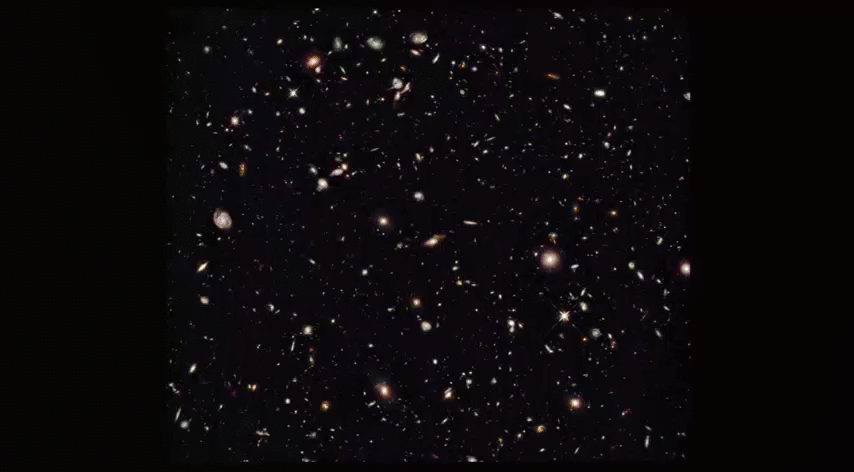
I know I just said I wasn’t going to be writing about it, but I’m sure you won’t mind looking at this gif of the Hubble Ultra Deep field that shows how tiny a space in the sky the image really represents. It’s mesmerizing, humbling, and one of the best embodiments of the cosmic perspective. Image credit: NASA/Hubble.
1: Water’s bizarre properties.
Water constantly amazes scientists, and its special properties are integral to life here on Earth. That’s why we’re constantly searching for water elsewhere in the cosmos, both within our solar system and beyond. The simple fact that water expands when it freezes, and thus becomes less dense, is by itself a little weird — most substances contract and gain density as they cool. Water is an excellent solvent capable of dissolving a wide variety of materials, and it has an amazing capacity to store and absorb energy. All those qualities alone would be enough to make water intriguing in my book, but there’s one other mysterious phenomenon that’s been observed in water that seems a little crazy: it appears to freeze faster when it’s hot. This is something that had been observed as far back as Aristotle’s time, and is known today as the Mpemba effect. There have been a variety of potential explanations for the process, but the mystery has never been conclusively settled. The latest and most plausible explanation for this effect is that the hydrogen bonds that hold water molecules together are more prominent in colder water. When the water is cooler, these hydrogen bonds between molecules bring them closer together — this in turn creates a repulsive effect within the molecule, causing the covalent oxygen-hydrogen bond to elongate and store energy. When water is heated, however, the effects of hydrogen bonding between molecules is significantly less, and thus that energy has already been removed from the system. When we cool the water down from that higher temperature, the process quickly brings the water molecules closer together and into their familiar icy crystalline structures. Because those pesky hydrogen bonds had already been taken care of, in a way freezing water from a warmer state may actually take less energy than freezing it from a cooler state.

An iceberg floating on the open ocean, something that shouldn’t look very surprising but in fact is actually quite unexpected. If water’s solid form were denser than its liquid form (like most substances) the oceans should freeze from the bottom up. Image credit: NASA/Jane Peterson
2: Most natural blues are not the result of pigments
You, like me, might remember sitting in high school biology class learning that the color of our skin is determined largely by how much of a pigment called melanin we produce. Melanin is not that diverse in its ability to produce a vibrant range of colors, however, so unfortunately we’ve been deprived of becoming one of nature’s more dazzling species. Other animals, however, have a variety of pigments that can produce a beautiful array of color. From a physics perspective, pigments work by absorbing most colors of light and reflecting the one that we see (a red frog absorbs every wavelength of light except for that red). Despite the many wonders of nature and the incredible biodiversity of our planet, there are almost no examples of blue pigments occurring in any animals. “But wait!” you might say, “my eyes are blue!”. Although blue as a color is rarer than others in nature, it does still occur (including in some of our eyes) — but if pigments aren’t the cause, what is? The answer is again rooted in the physics of light. Although different species accomplish the task slightly differently, the main idea is this — in most natural substances that appear blue, the reason they do so is because of their structure, not their color. Different colors of light have different wavelengths, and because of these different wavelengths they interact with surfaces slightly differently. Waves can also cancel out — the most common way you’ve probably experienced this is through noise cancelling headphones, which don’t actually block sound but instead listen to your environment and create more sound with precisely the right timing and frequency so that it cancels out the outside sound. If an animal wants to create a blue hue, the most common way that evolution has solved this problem is to evolve tiny structures that reflect and distort light in just the right way so that every color except for blue ends up out of phase and thus cancels itself out, leaving only the blue to bounce back towards your eye unaltered. Some greens in animals are also a result of this effect with the addition of yellow pigments — the yellow and the blue mix to form green. When one of these animals that uses this method dies, their body will often turn blue because the yellow pigment will no longer be produced yet the blue color is still created by the nanostructures left behind. Similarly, if you grind up a beautiful blue butterfly’s wings (although I’m not sure why you’d want to and it seems incredibly rude) you’ll be left with grey dust, not blue dust.

The blue in this peacock feather is a fantastic physics trick discovered and expertly employed by evolution. Image credit: Satdeep Gill/Wikipedia Commons.
3: The nature of light (and other particles)
The nature of light is something that has perplexed and confounded scientists for centuries. As we’ve learned more and more about light it has only gotten stranger and stranger. Even from the time of Newton, most scientists agreed that light had to either be a particle or a wave. A number of early experiments pointed more towards the wave direction, and helped show that (as is mentioned above) depending on its frequency waves of light interact with the world differently. Every other kind of wave scientists had studied up until this point, however, required some medium to travel through. Scientists searched for years conducting experiments to find some mystical “ether” through which light waves propagated, but were stumped. In the early 1900’s, scientists (including Einstein) showed that in fact light did not need a medium to through which to travel (a truly revolutionary idea) but also proved something far stranger — light was capable of both acting as a particle and a wave, depending on the experiment you performed. This bizarre particle-wave duality helped launch the even more bizarre field of quantum physics, which still has not been reconciled with Einstein’s theory of relativity, another bizarre consequence of the nature of light…
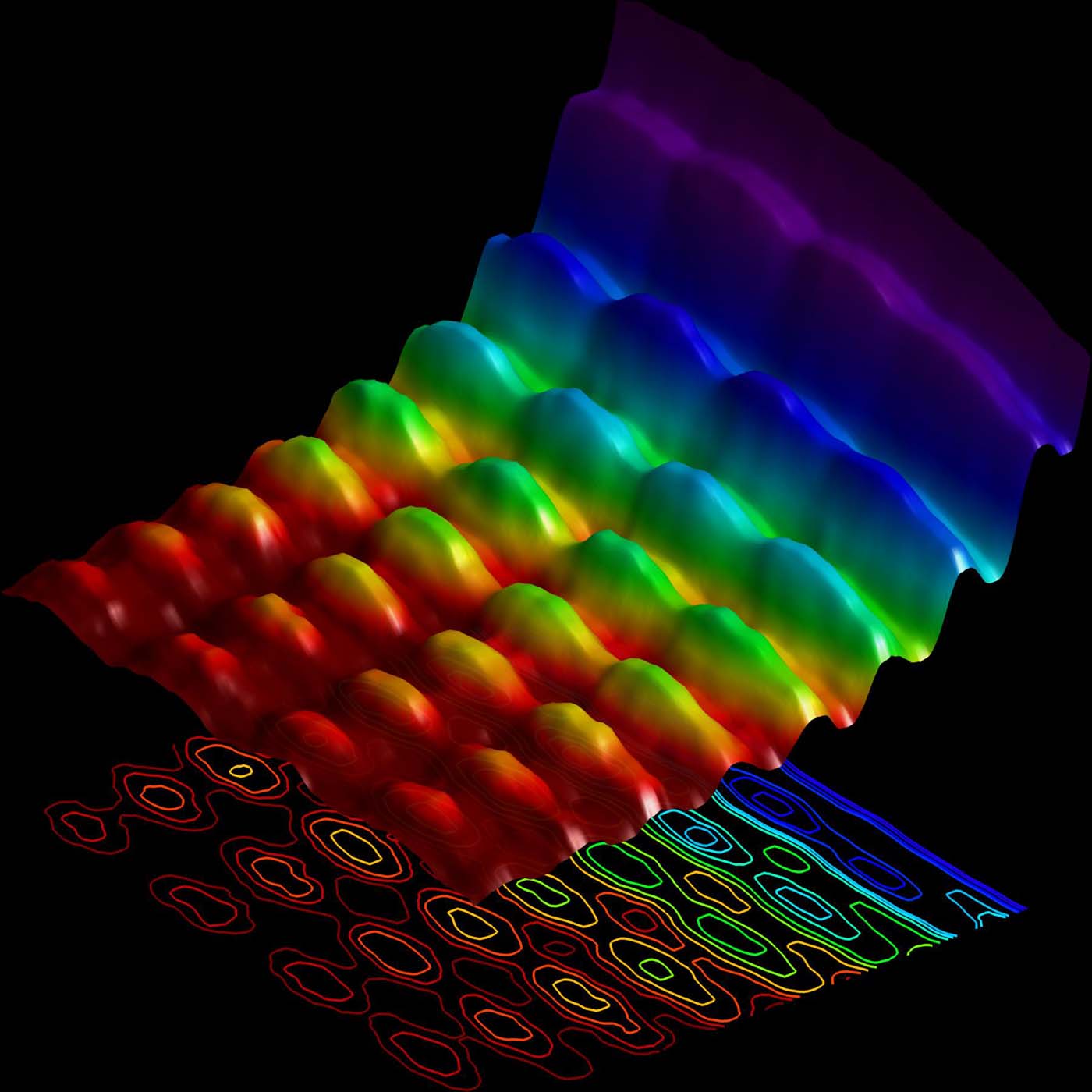
This image is the first visualization of light as both a particle and a wave. Read about how the experiment was carried out and how this fascinating image created. Image credit: EFPL.
4: Relativistic effects near the speed of light
One of the other revolutionary discoveries about light made in the early 1900’s was that it became apparent that the speed of light was the same for every observer regardless of their inertial reference frame. That might sound like a bunch of physics jargon, but if you actually consider its implications you might find your brain overheating. For anything else in the universe, all motion is relative, and that makes plenty of sense. I remember seeing a Mythbusters episode where they shot a ball out of the back of a truck (at exactly opposite the velocity the truck was traveling) and got it to fall straight down. From the perspective of the people in the truck, the ball flew out of the cannon at 60 mph (I don’t remember the actual speed they used but it’s the idea that matters). From the perspective of an observer watching the truck drive by however, the apparent velocity of the ball was zero and it just dropped straight to the ground. Einstein’s theory says that if both groups got into an argument about whether the ball actually moved or not, both of them would be correct, and that makes sense! What is much harder to wrap our brains around, however, is the idea that if we repeated that same Mythbusters experiment with a laser instead of a ball, the result would be different. An observer in the back of the truck would measure the laser leaving at the speed of light, but an observer on the ground would also measure it at the speed of light (the truck’s apparent velocity away from them would have no effect). How Einstein explained this seeming contradiction was through something that’s been popularized lately in science fiction — time dilation. Since the speed of light must be the same for everyone, some people must actually experience time “slower” relative to others — this is what allows the math to work out. You’re probably familiar with this idea from films like Interstellar. But what isn’t as often discussed in popular culture are two other strange predictions of Einstein’s theory — as an object approaches the speed of light it will shrink in length, and its apparent mass will increase.
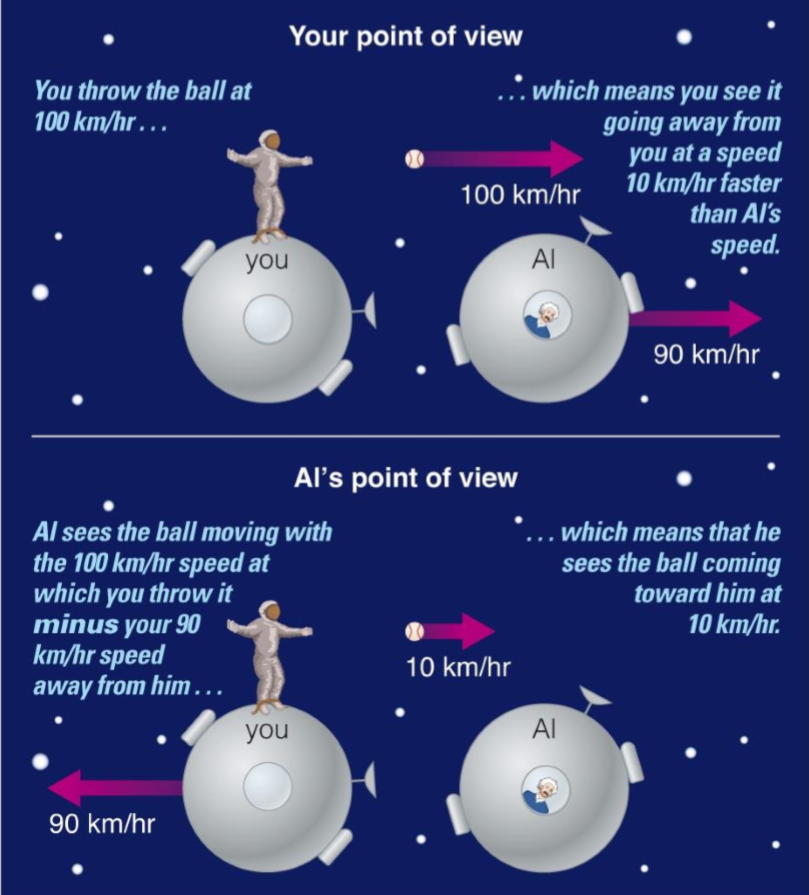
This is a common visualization of relative velocities, taken from one of my physics textbooks. Image credit: Pearson Education, 2014.
Consider a spaceship flying at 99.99% the speed of light past an observer who is at rest (relative to the ship). If at rest the ship is 100 meters in length, when it passes it will appear to have shrunk down to less than 2 meters (a remarkable slimming which no weight loss product can currently offer). Why? It again has to do with the speed of light and the relativity of time. Since the traveler in the spaceship is traveling much faster when compared with the person on the ground, the traveler’s clock would appear to tick slower to the observers. Pretend the observer used a laser to measure the distance from the front to the end of the spaceship — the time it took would return the distance if using the speed of light as a reference point. For the observer looking on the ground it will also take the same amount of time to measure the distance of the craft, but since their times are different relative to one another (1 second for the observer appears much faster than 1 second for the traveler) this means that if the observer measured that it took a certain small amount of time for the spaceship to pass by overhead, if the traveler measured the same distance from within his/her spaceship it would also take that same amount of time — only for the traveler (since their clock is running slower) that same amount of time would really be longer relative to the observer, meaning according to the observer the traveler should measure a longer length than the observer could. Since the longest an object can ever appear to be is its rest length, that means the observer must have measured the craft to be shorter. The even crazier thing about this is that, since all things are relative, the traveler would be equally justified in saying everything in the observer’s world had contracted and his/her spaceship was still its normal length (all size is relative in accordance with relativity).
Time dilation is incredibly bizarre, and it is another reason why the cosmic speed limit of the speed of light constrains future space travel. Since faster objects experience “slower” time compared with the rest of us, applying a force to them from the non-relativistic world has almost no effect. If you applied a huge force for a second here, that would be an imperceptibly small amount of time for something moving very close to the speed of light, meaning it wouldn’t accelerate hardly at all. When you get to the speed of light, time appears to stand still entirely, meaning you would no longer be able to accelerate the object simply because it would never know it had been accelerated. Since we know force to be equal to mass times acceleration, this means that for an observer on the outside if they are applying the same force but observing less change in acceleration the mass of the object must have changed — this is relativistic mass. Another consequence of time dilation is that photons that have travelled to us from the very beginning of the universe are still in fact very young (not 13.7 billion years old) because they’ve never had the chance to slow down enough to change throughout their lifespans. Although time dilation (and its accompanying effects) are truly strange to contemplate, most of us will never experience its effects. Relativistic effects depend largely on a factor called the Lorentz factor, which largely depends on a traveler’s velocity squared relative to the speed of light squared. The Apollo missions (which were the fastest manned missions) travelled at about 0.0036% of the speed of light, so you can see that their Lorentz factor will not be very different from someone here on Earth. A “normal” Lorentz factor for an observer at rest is 1, and an astronaut travelling to the moon would have a Lorentz factor of about 1.00000000064. This means that for every second that passed for someone in the command module at its fastest speed, 1.00000000064 seconds passed for everyone on Earth. If the Apollo astronauts had travelled at this speed for 53 years, everyone on Earth would be about a second older than them. And, since the command module was about 11 meters in length, at this speed it would have appeared from Earth to have been contracted by about 7 nanometers. As you can see, unless your velocity is very high you won’t experience much of a relativistic effect.
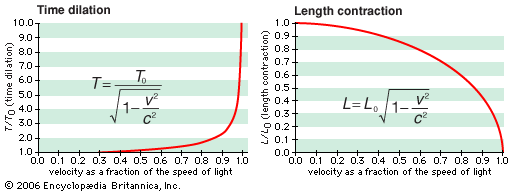
This graph shows how relative velocity impacts perceived time dilation and length contraction, illustrating how the effect is very small until getting close to the speed of light. Image credit: Encyclopedia Britannica, 2006.
Confused yet? Relativity is one of the strangest and intriguing ideas humanity has ever come up with, but best we can tell it is undeniably true.
5: Elon Musk’s Starman
Finally, there’s perhaps nothing more bizarre and previously unimaginable than what we all observed recently when Elon Musk and SpaceX launched a Tesla Roadster into space aboard their newest Falcon Heavy rocket (which is now the most powerful operational rocket humanity has). Watching those boosters come down and land themselves in near synchronicity, seeing Starman look out into deep space with Douglas Adams’s “Don’t Panic” emblazoned on the dash of that Tesla, and the sheer audacity and absurdity that Musk has been able to visualize are truly a moment worth celebrating. (Although I’m disappointed Starman forgot his towel.) Despite how awesome it really is, I have heard a small amount of backlash towards Musk for contributing to our space junk problem with his roadster. While space junk is certainly a growing problem, when testing a new rocket’s payload capability we often won’t send a real satellite aboard for fear of the whole thing blowing up. I’m a much bigger fan of Musk’s personal cherry red love letter to the cosmos drifting around in space for millions of years than a similarly weighted hunk of concrete, so I’m going to stick with my amazed reaction and wait with anxious anticipation for whatever he comes up with next.
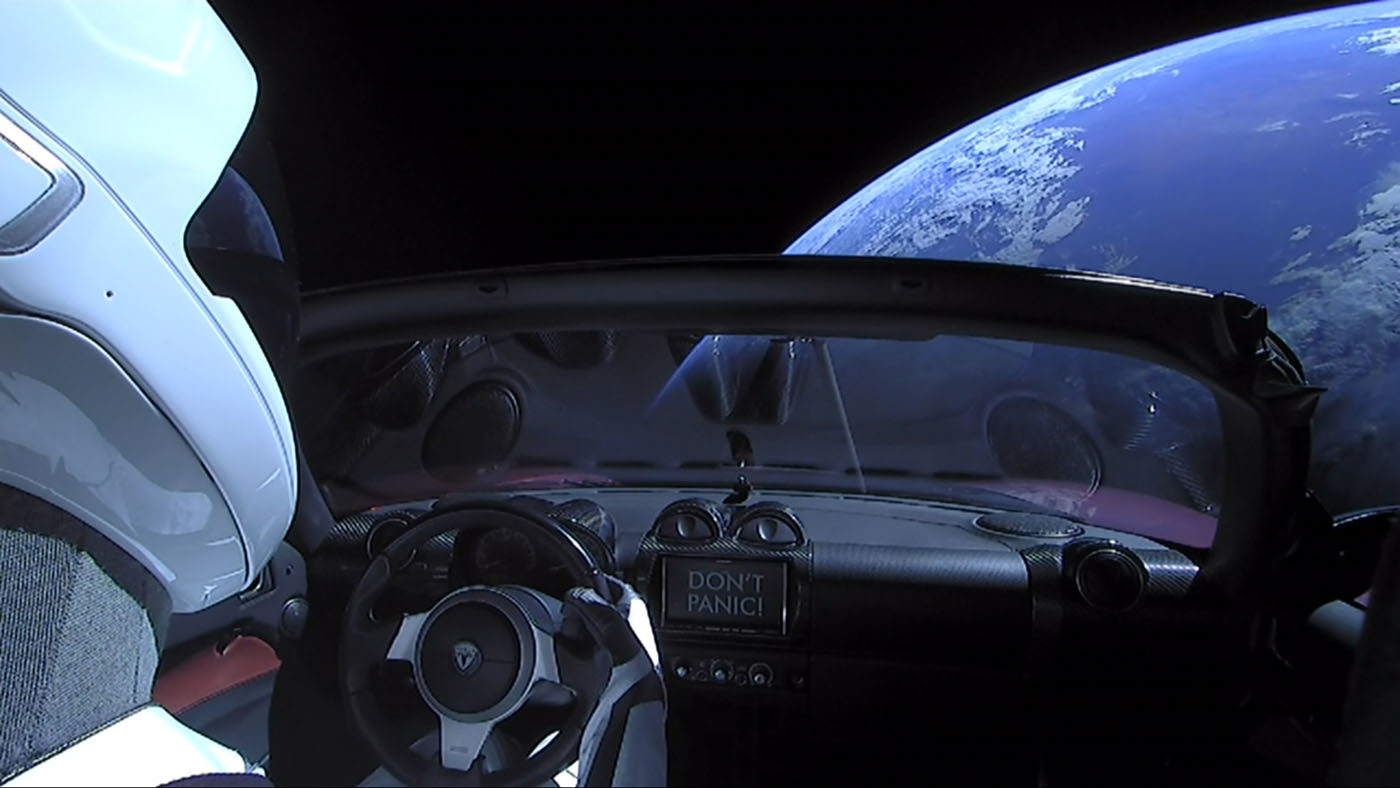
Elon Musk’s Starman looking back to Earth. Image credit: SpaceX.
What are the moments, ideas, or phenomena that inspire your love of science? Sound off in the comments, and from all of us at StarTalk, “Happy Valentine’s Day!”
Get the most out of StarTalk!
Ad-Free Audio Downloads
Ad-Free Video Episodes
Stickers & Mugs
Live Streams with Neil
Priority Cosmic Queries
Early-Access Videos
Learn the Meaning of Life
...and much more

 Become a Patron
Become a Patron

